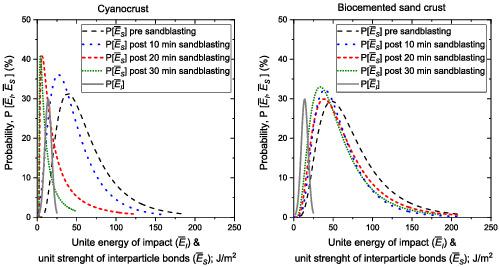当前位置:
X-MOL 学术
›
Earth Surf.Process. Land.
›
论文详情
Our official English website, www.x-mol.net, welcomes your
feedback! (Note: you will need to create a separate account there.)
A framework for predicting abrasion rupture of crusts in wind erosion
Earth Surface Processes and Landforms ( IF 2.8 ) Pub Date : 2021-07-06 , DOI: 10.1002/esp.5194 Seyed Mohammad Fattahi 1 , Abbas Soroush 1 , Ning Huang 2 , Jie Zhang 2 , Sona Jodari Abbasi 3 , Yang Yu 2
Earth Surface Processes and Landforms ( IF 2.8 ) Pub Date : 2021-07-06 , DOI: 10.1002/esp.5194 Seyed Mohammad Fattahi 1 , Abbas Soroush 1 , Ning Huang 2 , Jie Zhang 2 , Sona Jodari Abbasi 3 , Yang Yu 2
Affiliation

|
Crusts play a crucial role in the reduction or control of wind erosion. In this regard, the resilience and durability of crusts are of prime importance. Crusts have high resilience and durability against wind flow shear stresses; however, they are prone to abrasion induced by saltating particles. Therefore, estimating crust durability in abrasion rupture has practical importance. In this study, a cyanocrust and a biocemented sand crust were subjected to a controlled flux of saltating particles for different sandblasting periods to provide a framework for predicting crust rupture. The velocity and pre- and post-collision energy of the saltating particles were measured using high-speed photography. The changes in the strength of the crusts after different periods of sandblasting were determined using a scratch test. The results suggested that the average strength of the cyanocrust and biocemented sand crust became 0.25 and 0.7 of their corresponding initial values after 30 min of sandblasting. Also, the average stiffness of the cyanocrust and biocemented sand crust decreased to 0.5 and 0.9 of their initial values, respectively. Furthermore, the amount of impact energy absorbed by the crusts increased by the deterioration of the crusts. Compiling the results of the wind tunnel experiment and scratch tests yielded an exponential equation which can be used to estimate crust durability in a given condition of saltation. Based on this equation, the cyanocrust and biocemented sand crust will break down entirely after 23 and 449 min, respectively, at a wind velocity of 6.8 m/s and a saltation flux of 1 g/s/m.
中文翻译:

预测风蚀中结壳磨损破裂的框架
地壳在减少或控制风蚀方面起着至关重要的作用。在这方面,地壳的弹性和耐用性是最重要的。地壳对风流剪切应力具有高回弹力和耐久性;然而,它们容易受到盐化颗粒引起的磨损。因此,估计磨损破裂时的外壳耐久性具有实际意义。在这项研究中,蓝藻地壳和生物胶结砂壳在不同喷砂周期内受到受控的盐化颗粒通量的影响,以提供预测地壳破裂的框架。使用高速摄影测量跳跃粒子的速度和碰撞前和碰撞后的能量。使用划痕测试确定不同喷砂时间后结壳强度的变化。结果表明,喷砂30分钟后,蓝藻壳和生物胶结砂壳的平均强度分别为相应初始值的0.25和0.7。此外,蓝藻地壳和生物胶结砂地壳的平均刚度分别下降到初始值的 0.5 和 0.9。此外,结壳吸收的冲击能量随着结壳的恶化而增加。汇总风洞试验和划痕试验的结果,得出了一个指数方程,可用于估计给定跃迁条件下的地壳耐久性。根据该方程,在风速为 6.8 m/s 和跃迁通量为 1 g/s/m 的情况下,蓝藻壳和生物胶结砂壳将分别在 23 分钟和 449 分钟后完全分解。
更新日期:2021-07-06
中文翻译:

预测风蚀中结壳磨损破裂的框架
地壳在减少或控制风蚀方面起着至关重要的作用。在这方面,地壳的弹性和耐用性是最重要的。地壳对风流剪切应力具有高回弹力和耐久性;然而,它们容易受到盐化颗粒引起的磨损。因此,估计磨损破裂时的外壳耐久性具有实际意义。在这项研究中,蓝藻地壳和生物胶结砂壳在不同喷砂周期内受到受控的盐化颗粒通量的影响,以提供预测地壳破裂的框架。使用高速摄影测量跳跃粒子的速度和碰撞前和碰撞后的能量。使用划痕测试确定不同喷砂时间后结壳强度的变化。结果表明,喷砂30分钟后,蓝藻壳和生物胶结砂壳的平均强度分别为相应初始值的0.25和0.7。此外,蓝藻地壳和生物胶结砂地壳的平均刚度分别下降到初始值的 0.5 和 0.9。此外,结壳吸收的冲击能量随着结壳的恶化而增加。汇总风洞试验和划痕试验的结果,得出了一个指数方程,可用于估计给定跃迁条件下的地壳耐久性。根据该方程,在风速为 6.8 m/s 和跃迁通量为 1 g/s/m 的情况下,蓝藻壳和生物胶结砂壳将分别在 23 分钟和 449 分钟后完全分解。









































 京公网安备 11010802027423号
京公网安备 11010802027423号